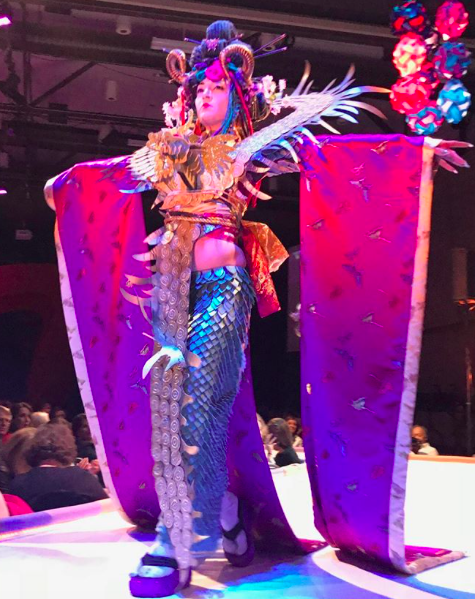By WIN GRUENING
SENIOR CONTRIBUTOR
Melting pot: a place where a variety of races and cultures assimilate into a cohesive whole that often results in invigoration or novelty – Merriam-Webster Dictionary
The bulk of my life experience has been centered around two highly regulated and regimented careers – the military and the banking industry. It goes without saying that neither tolerated much diversity of opinion or creative flair.
For that, we have the arts.
That is, until some in the arts community decided artists had to ask permission to be creative, take risks and be provocative.
I’m, of course, referring to the recent dust-up involving the Wearable Art Show sponsored by the Juneau Arts and Humanities Council (JAHC). Titled a “Spectacular Celebration of Creativity”, artists were encouraged to “explore, experiment, and showcase.”
Despite this glowing promise, one entry this year caused considerable controversy and was ultimately removed from the show. The entry, by artist Beth Bolander, “Doragon,” was heavily influenced by Asian artwork and fashion. The piece included a silk kimono-like garment with a dragon-inspired theme and facial makeup reminiscent of a geisha.
When Dani Gross (who has Alaska Native ancestry) modeled Bolander’s creation, it was roundly cheered and won third-place. Yet, some said it promoted Asian stereotypes. This sparked a heated debate about cultural appropriation that led to its removal and several apologies by the JAHC Board.
Additionally, JAHC promised to hold meetings about cultural appropriation, implement policies for next year’s Wearable Art Show, and provide “equity” training for staff and board members.
Fordham law professor Susan Scafidi defines cultural appropriation as “taking intellectual property, traditional knowledge, cultural expressions or artifacts from someone else’s culture without permission including…… dance, dress, music, language, folklore, cuisine, traditional medicine, religious symbols, etc.” (Neither Bolander nor Gross are of Asian descent.)
The issues involved generated a firestorm of criticism of JAHC from all sides – from those believing “Doragon” was not only insensitive but racist – to those believing JAHC’s response was caving to “political correctness” and was an example of reverse racism.
As the apparent arbiter of all things cultural, JAHC should have realized what a slippery slope this can be.
While waiting to learn what the limits of free expression will be in our community, here are a few questions the JAHC Board could consider before diving headlong into this quagmire.
- Will there be separate committees monitoring every featured art form? Who will give permission from the appropriate culture, if needed?
- Will these new policies apply to artwork, jewelry and merchandise sold by the JAHC? What about food served at events?
- Will information be requested on the ethnicity of artists? How will that information be verified?
I don’t dispute there are instances of artistic insensitivity (intentional or not) that mock, marginalize, or exploit other races and cultures. Those are never okay. But that isn’t the intent of “Doragon” – which celebrated the beauty and artistry of Asian culture.
Most art organizations, in the name of artistic expression, have had no problem defending other “offensive” works of art such as “Immersion (Piss Christ)” that depicts the crucifixion of Christ submerged in a small glass tank of the artist’s urine. Despite the controversy it generated, it was a National Endowment of the Arts-sponsored award winner.
It’s illogical that any arts organization advocating freedom of expression would yield to the tyranny of the cultural-appropriation crowd.
Creative collaborations, and yes, cultural appropriation, can enrich our lives. Conversely, guarding cultures to preserve them stifles creativity and prevents the free exchange of ideas, styles, and traditions – which should be the hallmark of any multicultural society.
In a larger context, our culture of freedom is slowly being erased by increasingly militant groups: oversensitive critics offended by anyone coloring outside the lines, speaking their mind or straying across some arbitrary boundary of political correctness.
Juneau, like many communities across our state, is a true melting pot. Only 50% of children in our schools are Caucasian – with the other half mostly Alaska Native, Asian, Hispanic, or an ethnic mixture.
Why deny anyone the full richness of sharing of cultures by telling them they “can see but not touch”? For over 200 years, this has never been the inspiration that brought people to America.
Juneau can do better.
Win Gruening was born and raised in Juneau and retired as the senior vice president in charge of business banking for Key Bank in 2012. He is active in civic affairs at the local, state, and national level.

Thank you for this thoughtful article. It states my thoughts exactly. America IS a melting pot and we’ve always been proud of that. We celebrate the wonderful mixture of cultures that make America what it is. The idea of cultural appropriation is not American. It comes from a group of people who feel they have to regulate and categorize and marginalize every single person. They love control. What a shame for Juneau.
Non Mexicans can not sell Mexican food in Portland, Oregon. Just one week after Kooks Burritos in Portland, Ore., was featured in a profile for local publication Willamette Week, the pop-up Mexican food cart has closed down amid accusations that they ripped off their recipes.
Kali Wilgus and Liz “LC” Connelly, the two white women who started Kooks earlier this year, have been accused of stealing their techniques from the “tortilla ladies” of Puerto Nuevo, Mexico — because Connelly told Willamette Week that they gathered their recipes and tortilla-making processes during a holiday road-trip to the Baja California village.
“I picked the brains of every tortilla lady there in the worst broken Spanish ever, and they showed me a little of what they did,” she told the site. “They told us the basic ingredients, and we saw them moving and stretching the dough similar to how pizza makers do before rolling it out with rolling pins.”
Imitation is the most sincere form of flattery!
Comments are closed.